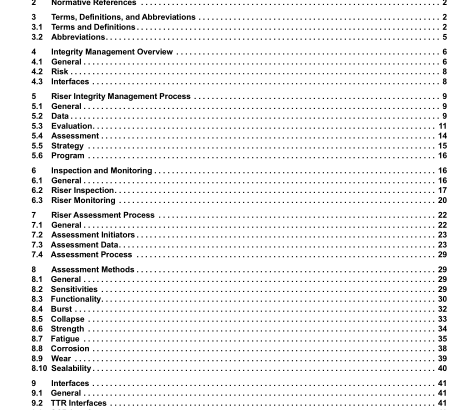API RP 2RIM:2019 pdf free download.Integrity Management of Risers from Floating Production Systems
Approaches to IM vary depending upon field life, type of riser, type of host platform, service conditions (e.g. internal pressure, temperature, fluid properties), and sophistication of regional infrastructure in which the riser is located. These factors influence the philosophical approach to IM that can vary from a riser involving emphasis on the use of monitoring equipment, to another riser with a preference for the extensive use of inspections. Regardless of the chosen IM approach, the purpose of the IM is to manage the integrity of the riser throughout its service life.
The IM process can be used to demonstrate that the risks to riser operations are understood and to prevent and/or mitigate incidents that could result in safety, environmental, or economic consequences to the owner. Choices are made in the design (e.g. selection of materials, design margins, operating procedures, condition monitoring systems, new or proven technology, robustness of design, redundancy, and fabrication/installation methods) that will influence IM activities during the operations.
Implementation of an IM process can benefit from design decisions, such as providing access for inspection and maintenance. Initial IM development begins as part of the riser’s design or reuse, ideally during the riser’s concept and select stages. The IM process is used to develop an inspection and monitoring program, including scope and frequency that can provide additional information on the condition of the riser.
The collected information can be used to understand present and emerging risk from operating the riser and can provide information for determining the ongoing strategy for mitigating the emerging risk.
A well-implemented IM process can provide evidence that the riser remains fit-for- service for the operational life of the riser and through to decommissioning.
Throughout the service life of the riser, new data are collected through monitoring activities, scheduled maintenance, scheduled inspections, results of accidental events, or planned changes (e.g. modifications or additions) to the riser.
As new data are obtained, the data are subject to engineering evaluation to validate fitness-for-service. Based on the evaluation, adjustments to the strategy plans and program work scopes can be required to confirm fitness-for-service and maintain the riser’s integrity. More detail on each of the elements is provided in Section 5.
4.2 Risk The owner/operator should adopt risk-based principles for developing IM strategies that consider the present condition of a riser, the likelihood of damage or degradation of the riser, and the potential consequences. The consequences of failure should include the potential for loss of life, as well as undesired environmental and/or economic impacts (e.g. repairs, clean up, replacement, and deferred production). A risk-based approach recognizes that risers with higher risks could warrant more frequent and more focused inspections than lower risk risers. During the development of an inspection strategy, a risk category can be used for setting inspection intervals and work scopes as part of a risk-based IM strategy.
4.3 Interfaces This RP is a companion to three other RPs within API that address integrity management: — API 2SIM, Structural Integrity Management of Fixed Offshore Structures
— API 2FSIM, Floating Systems Integrity Management
— API 2MIM, Mooring Integrity Management
The owner/operator is responsible for understanding and managing the interfaces between the integrity management for each of these interrelated RPs.
For guidelines and recommended practices relating to planning, designing, and constructing risers, including reuse and change-in-use of existing risers, the recommendations in the following industry standards should be considered: API 2RD, API 17B, API 17J, API 17K, API 17L1, API 17L2. Other international standards such as DNV-OS-F201, DNV-RP-F203, DNV-RP-F206 can be considered as well.API RP 2RIM pdf download.API RP 2RIM:2019 pdf free download
